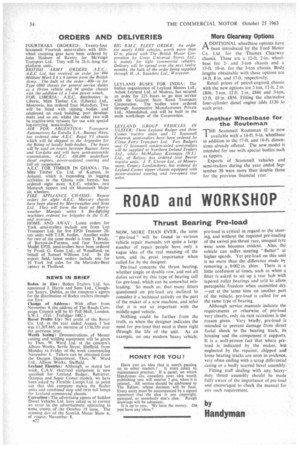ROAD and WORKSHOP
Page 36

If you've noticed an error in this article please click here to report it so we can fix it.
Thrust Bearing Pre-load
NOW, MORE THAN EVER, the term "pre-load" will be found in various vehicle repair manuals, yet quite a large number of repair people have only a vague idea of the real meaning of the term, and its great importance when called for by the designer.
Pre-load concerns the thrust bearing, whether single or double row, and not all duties served by this type of bearing call for pre-load, which can be somewhat misleading. So much so, that many fitters questioned on pre-load are inclined to consider it a technical activity on the part of the maker of a new machine, and infer that it is not so important with the middle-aged vehicle.
Nothing could be further from the truth, as when the designer indicates the need for pre-load that need is there right through the life of the unit. As an example, on one modern heavy vehicle, pre-load is critical in regard to the steering, and without the required pre-loading of the swivel pin thrust race, unequal tyre wear soon becomes evident. Also, the vehicle can suffer steering "flutter" at higher speeds. Yet pre-load on this unit is no more than the difference made by removing a .0.002 in. shim. There is a little confusion at times, such as when a fitter is asked to set up a rear hub with tapered roller bearings and told to allow perceptible freedom when assembled dry --yet at the same time on another part of the vehicle, pre-load is called for on the same type of bearing.
Although service manuals indicate the requirements or otherwise of pre-load very clearly, only on rare occasions is the reason given. Very briefly, pre-load is intended to prevent damage from direct facial shock to the bearing track, its housing and the component it supports. It is a well-proven fact that where preload is indicated by the maker, but neglected by the repairer, chipped and loose bearing tracks are soon in evidence, very often ending with a scrap differential casing or a badly scarred bevel assembly.
Fitting staff dealing with any heavyduty thrust assembly should be made fully aware of the importance of pre-load and encouraged to check the manual for any such requirement.
by
Handyman




























































































